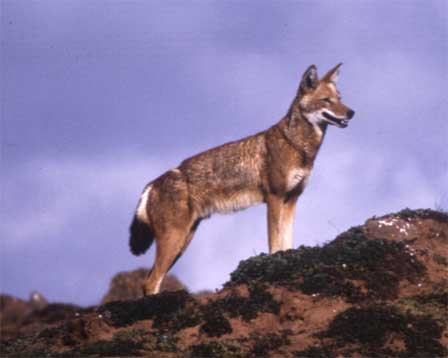
Introduction
Location Map
Base Map
Database Schema
Conventions
GIS Analyses
Flowchart
GIS Concepts
Results
Conclusion
References
CONCLUSIONS
Our analysis shows the areas of highest risk for rabies in the endangered Ethiopian wolf in Bale Mountain National Park (BMNP). We integrated attributes from three main components (vegetation type, location of water, and location of villages) to designate risk levels for each pack within the park. Packs at highest risk for an outbreak of rabies occur in areas of herbaceous/grassland vegetation coverage where local pastoralists graze their cattle. These high-risk packs are also in close proximity to water and local population centers; all of these factors increase contact between the Ethiopian wolf and the domestic dogs accompanying cattle herds. Since dogs are the main carrier of rabies in BMNP, increased contact equates with increased risk of disease transmission.
According to our analysis, the packs at highest risk for rabies occur mostly in the Web Valley and in the far southeastern corner of the Sanetti Plateau (see figure 1, Results). Three packs in the Web Valley area are considered at high risk, and three more at moderately high risk. Two packs in the Sanetti Plateau area are considered at moderately high risk, and one is at moderate risk. In Morebawa, one pack is at high risk, one at moderately high risk, and one at moderate risk. The pack occupying the corridor between Web Valley and Morebawa is designated moderately high in risk.
When we compare our results to known rabies carcasses from the last outbreak in 2003-2004, we find high correlation between our packs at high risk for rabies and known occurrences of rabies (see figure 2, Results). That outbreak decimated the Web Valley subpopulation, but a reactive vaccination regime managed to prevent the spread of rabies to the other two subpopulations.
Policy recommendations:
- Packs in BMNP should be routinely monitored for signs of a rabies outbreak, and a reactive vaccination plan put into effect as soon as a death by rabies is confirmed. It seems to be most effective and cost efficient to vaccinate a coronal area around the affected pack in order to prevent spread. GIS can be used to provide a quick and appropriate buffer zone for this purpose.
- In order to prevent the transmission of disease and hybridization, contact should be minimized between domestic dogs and Ethiopian wolves. This could be carried out in a variety of ways, including:
- Creation of wildlife reserves in areas occupied by wolf packs. This would prevent the use of these habitats for cattle grazing, decreasing contact between wolves and domestic dogs and eliminating competition between rodents (the wolves’ prey base) and cattle. However, this loss of grazing land may cause problems for the local pastoralists that depend on wolf habitat for cattle forage. This problem could be overcome by the government providing extra forage for cattle, which may be an expensive and unrealistic expection. This solution doesn’t remove the problem of migrant un-owned dogs which might carry the rabies virus into the protected habitat, but it does remove the direct effect of human activities.
- Mandatory vaccination of all dogs within 30 km of wolf packs. This strategy might prevent a rabies outbreak, but doesn’t address the problem of hybridization.
- Reduction of domestic dog population. This could be carried out through a systematic process of spaying/neutering existing dogs, a program of oral birth control for dogs, and euthanasia of non-owned or feral dogs which are more likely to come into contact with wolves. Problems with this strategy include the price and time commitment, and the difficulty in catching all ‘domestic’ dogs for neutering.
- Availability of alternative methods of protecting livestock from predators. A communal area surrounded by electric fence would decrease predator attacks at night, when dogs are most useful. If alternative methods are shown to be effective at preserving a herd, pastorilists may be persuaded to abandon the use of dogs, and the rabies reservoir would be removed from the area.
- An effort should be made to allow licensing and use of oral vaccination of Ethiopian wolves as a more cost and labor efficient rabies prevention measure; this method is also less invasive to the endangered species. We recommend a preventative vaccination regime in those packs designated high risk by our analysis rather than a blanket prophylactic vaccination program (which was judged impractical by local authorities as expensive and labor intensive (Haydon et al 2006). This targeted vaccination program, in addition to measures taken to reduce the local domestic dog population, may help to prevent another devastating outbreak of rabies in the highly endangered Ethiopian wolf.
This project also illustrates the usefulness of GIS in conservation--it provides a powerful and useful tool for quickly and efficiently determining high-risk populations.
